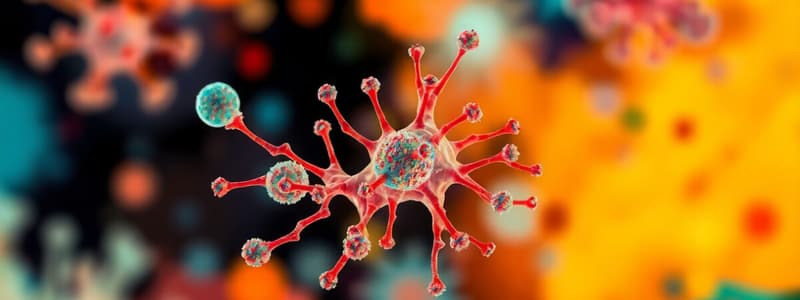Podcast
Questions and Answers
What is the main characteristic of a bactericidal drug?
What is the main characteristic of a bactericidal drug?
- It kills the target bacteria. (correct)
- It enhances bacterial growth.
- It requires higher doses for effectiveness.
- It halts bacteria growth temporarily.
Which type of antimicrobial specifically targets only gram-positive bacteria?
Which type of antimicrobial specifically targets only gram-positive bacteria?
- Broad-spectrum antimicrobial.
- Synthetic antimicrobial.
- Narrow-spectrum antimicrobial. (correct)
- Semisynthetic antimicrobial.
What does the Kirby-Bauer disk diffusion test measure?
What does the Kirby-Bauer disk diffusion test measure?
- The antibacterial activity of antimicrobial agents. (correct)
- The clear zone of bacterial growth.
- The potency of a synthetic antimicrobial.
- The time taken for bacteria to die.
What does the minimal inhibitory concentration (MIC) signify in antibacterial dilution tests?
What does the minimal inhibitory concentration (MIC) signify in antibacterial dilution tests?
Which of the following statements about semisynthetic antimicrobials is true?
Which of the following statements about semisynthetic antimicrobials is true?
What is the primary purpose of controlling microbial growth?
What is the primary purpose of controlling microbial growth?
Which of the following is NOT a requirement for BSL-2 laboratories?
Which of the following is NOT a requirement for BSL-2 laboratories?
In which Biological Safety Level are laboratory workers required to wear a respirator?
In which Biological Safety Level are laboratory workers required to wear a respirator?
What key characteristic distinguishes BSL-4 laboratories from lower levels?
What key characteristic distinguishes BSL-4 laboratories from lower levels?
What safety feature is essential in BSL-3 laboratories?
What safety feature is essential in BSL-3 laboratories?
How is air pressure maintained in a full-body protective suit in BSL-4 laboratories?
How is air pressure maintained in a full-body protective suit in BSL-4 laboratories?
What is a common feature of all Biological Safety Levels?
What is a common feature of all Biological Safety Levels?
Which item is primarily used for sterilizing materials in BSL-2 laboratories?
Which item is primarily used for sterilizing materials in BSL-2 laboratories?
Flashcards
Bacteriostatic drug
Bacteriostatic drug
A drug that causes a reversible inhibition of bacterial growth.
Bactericidal drug
Bactericidal drug
A drug that kills bacterial cells.
Narrow-spectrum antimicrobial
Narrow-spectrum antimicrobial
Targets only specific types of bacteria.
Broad-spectrum antimicrobial
Broad-spectrum antimicrobial
Signup and view all the flashcards
Minimal inhibitory concentration (MIC)
Minimal inhibitory concentration (MIC)
Signup and view all the flashcards
BSL-1 Lab
BSL-1 Lab
Signup and view all the flashcards
BSL-2 Lab
BSL-2 Lab
Signup and view all the flashcards
BSL-3 Lab
BSL-3 Lab
Signup and view all the flashcards
BSL-4 Lab
BSL-4 Lab
Signup and view all the flashcards
Biological Safety Cabinet
Biological Safety Cabinet
Signup and view all the flashcards
Standard Aseptic Technique
Standard Aseptic Technique
Signup and view all the flashcards
Laboratory Biological Safety Levels
Laboratory Biological Safety Levels
Signup and view all the flashcards
Microbe Containment
Microbe Containment
Signup and view all the flashcards
Study Notes
Control of Microbial Growth
- Preventing human disease spread requires controlling microbial growth and abundance.
- Laboratory personnel working with pathogens require different levels of control based on pathogen risk.
Laboratory Biological Safety Levels
- BSL-1: Standard aseptic technique, open benches, laboratory coat, goggles, and gloves as needed. No major modifications.
- BSL-2: Restricted access, face shields in some circumstances, biological safety cabinets, self-closing doors, eyewash stations, and autoclaves for sterilization.
- BSL-3: Restricted access, medical surveillance (vaccinations). Staff wear respirators and work in biological safety cabinets. Hands-free sinks, eyewash near exit, and double self-closing and locking doors. Directional airflow.
- BSL-4: Full-body protective suits with designated air supply or work within biological safety cabinets with HEPA-filtered exhaust. Air pressure in the suit is higher than outside. Separate building and its own air supply. Decontamination procedures on entry/exit.
Methods for Controlling Microbial Growth
-
Disinfection: Reduces or destroys microbial load on inanimate items using heat or chemicals.
-
Sanitization: Reduces microbial load to safe public health levels on inanimate items.
-
Sterilization: Completely eliminates all vegetative cells, endospores, and viruses on inanimate items. Methods include steam (autoclave), chemicals, and radiation.
-
Antisepsis: Reduces microbial load on skin or tissues using chemicals.
-
Degerming: Reduces microbial load on skin or tissues through scrubbing and mild chemicals.
Antimicrobial Drugs
- Synthetic antimicrobials: Developed from chemicals not found in nature.
- Semisynthetic antimicrobials: Chemically modified derivatives of natural antimicrobials (e.g., penicillin).
- Bacteriostatic drugs: Cause reversible inhibition of bacterial growth (growth restarts upon drug removal).
- Bactericidal drugs: Kill target bacteria.
Spectrum of Activity
- Narrow-spectrum antimicrobials: target specific bacterial pathogens (some target only gram-positive bacteria).
- Broad-spectrum antimicrobials: target a wide variety of bacterial pathogens (both gram-positive and gram-negative).
Testing the Effectiveness of Antimicrobials
- Kirby-Bauer disk diffusion test: Observe clear circular zones of inhibition around drug-impregnated disks. Measures antibacterial activity.
- Dilution tests: Used to determine a drug's minimum inhibitory concentration (MIC) and minimum bactericidal concentration (MBC). The MIC is the lowest concentration that inhibits visible growth, and the MBC is the lowest concentration that kills ≥99.9% of the initial inoculum. Dilution tests are done using test tubes or plates.
- Etest: A rapid method of determining the MIC of an antibiotic.
Studying That Suits You
Use AI to generate personalized quizzes and flashcards to suit your learning preferences.




